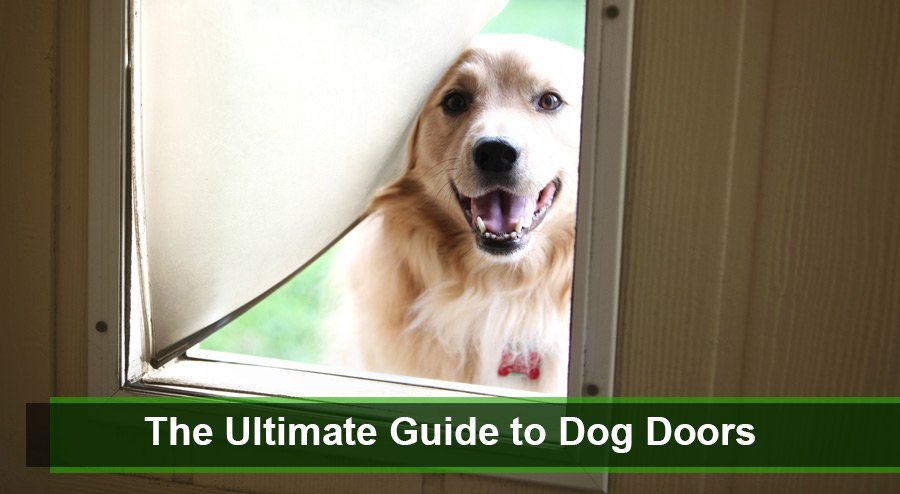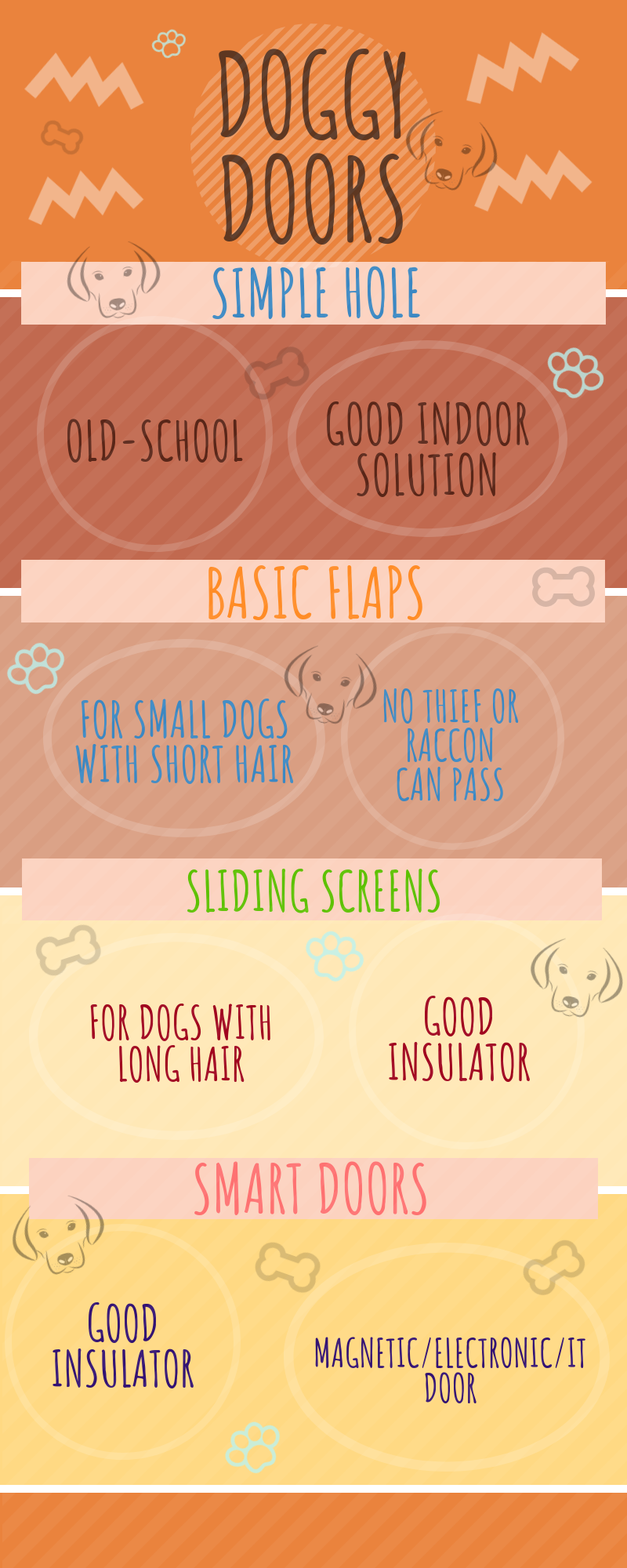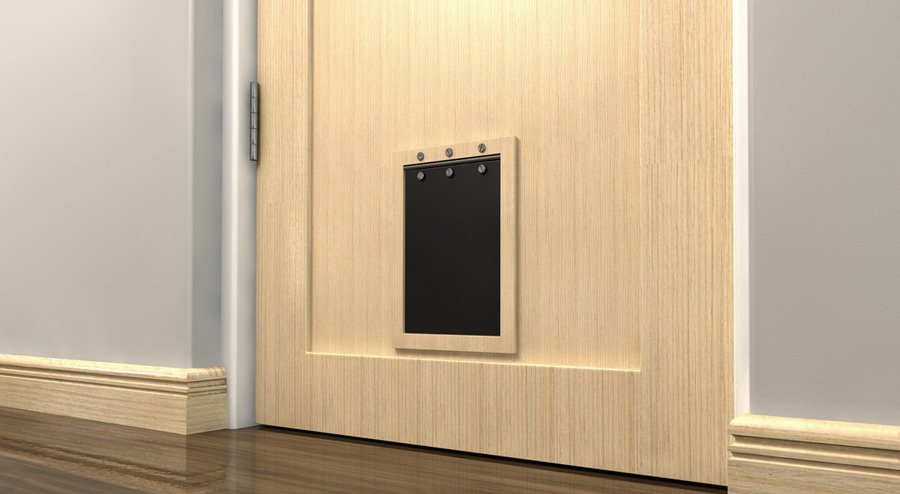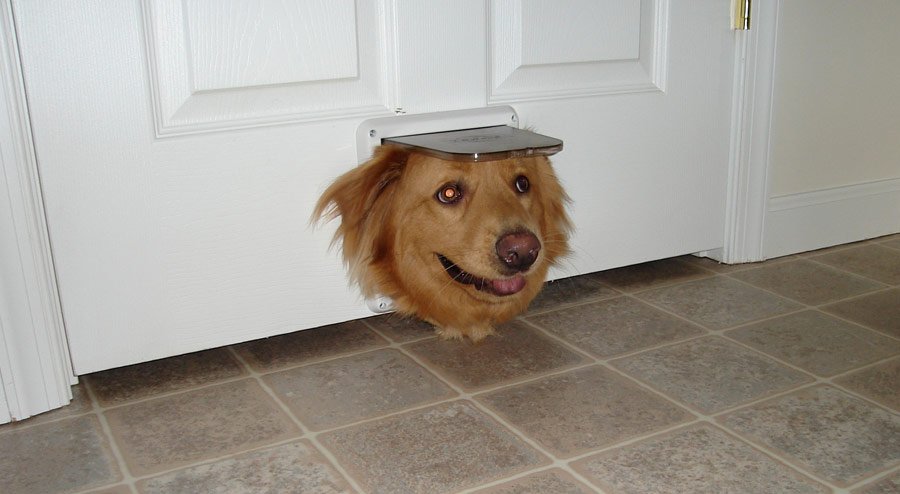If you have a yard where your dog can safely leave to get some more space or go to the bathroom, dog doors could be the difference of needing to remember to let the dog in our out every time, and coming home to a pet that is already walked and happy to see you. This guide to dog doors will teach you what to look for, what are the advantages of different pet doors, and how you can incorporate them into your home.
As there are no two dogs that are alike, there is no such thing as the perfect doggy door. Your choice must be based on where your home is, how your neighborhood is, how big is your dog, as well as your personal taste and style.
Contents
What are Dog Doors
Most of us became familiar with dog doors through movies and television series where the family, inexplicably for today’s standards, lives the American Dream, with a nice two-story house with a white picket fence. While this is a good intro, it is also the base of many misconceptions about styles and positioning of doggy doors.
In its core, a pet door is a small door that is on or beside the main entrance and doesn’t require opposable thumbs to open. This can be a flap or just a magnetic panel, but can also be much more intricate. Additionally, the doggy door can be internal, opening a pathway for your pet to enter other rooms or even the garage.
Styles and Shapes
The size and design of the pet door can vary immensely, especially today. From basic flaps to intricate smart doors that will recognize your pet and open automatically, you can see almost everything. In some cases, especially when it is an indoor opening, there isn’t even a flap but just a hole where your canine can pass to another room.
The only thing that you will never see is what is the television standard, and that is a huge flap opening on the back door for breeds like the German Shepherd or a Golden Retriever. Huge flaps are not only a problem when it comes to insulation, but are also a literal open door when it comes to a home invasion.
Mind the Size of Your Dog
Obviously, the size of the doggy door you are installing should be enough for your dog to pass through. On the other hand, they should be small enough to be safe against other creatures. This may include raccoons, opossums (not to be mistaken with Australian possums), as well as burglars.
Finally, the canine door is usually not going all the way to the ground, as this can be a pest opening. Because of this, you will need to take into the account not only the size of your dog’s head and shoulders but the length of their legs as well. The door should be high enough so that they don’t need to crouch to go through, but low enough so that they can step over them easily.
Take into Account the Hair Length
This is a very serious issue that most pet owners forget while they are buying dog doors. Not only do some dogs need haircuts, but some breeds naturally have a longer mane, or even longer hairs everywhere. Because of this, you need to find a door that will either be big enough for your dog to pass though without entangling, or shaped so that the hairs can’t be stuck in the door.
For dogs with longer hair, types of dog doors that have flaps or similar features shouldn’t be used. Instead, you may want to use a sliding door, or a screen that has magnetic hinges. Finally, a bigger door with a sensor focused on your dog’s RFID chip might be the best option. High-tech doors might be slightly more expensive if you are buying them pre-made, but they are usually much better than any traditional design.
Positioning Dog Doors inside the Home
The positioning of the doggy door is probably the most important thing when planning your installation. Whether outdoor or indoor, it is important that all of the safety features are taken into consideration, while also providing your dog with an opening that it needs.
If you have a small dog, this will be significantly easier. In this case, you can also install a dog door for walls, which can be half a dozen inches wide and offer both a great passage and ample security. Bigger dog breeds require a bit more planning, but they are far from being hard to install.
When installing the door, make certain that it is not on the windy side of the house, as dust and rain might fall in. Also, ensure that there is at least a bit of dry and covered area before the entrance, as the dog might track water and mud from the patio or back yard.
Insulating the Doggy Door
There are several ways to insulate your pet door from both noise and heath, as well as the elements. Even if you are not using a sliding door or an electronic smart door, you may be able to use double flap openings. This will keep most unwanted things out of your house while letting your furry friend pass through with ease.
The best insulator, not only for doggy doors but in general, is a vacuum. If you can have a door that has two panels without anything (including air) in between, waves will not be able to travel, and this includes both sound waves and oscillating particles, as well as heat.
Finally, rubber is also a good material. It doesn’t conduct heat or sound, it is water resistant and not really flammable. Depending on the climate of your area, a double flap entry made from rubber might be just as good as a high-end PVC sliding door.
Defense against the Elements
Including your dog door into your home building is a prudent move, as this feature can either be a great help in your daily life or a nightmare. You must make sure that you made all of your entrances as safe as possible and chose an option for your dog door that is as insulated and protected as the rest of your home.
Dog doors are usually forgotten because of their small size, as people think that those few inches will not make a difference. This may be true for burglars and critters, but fire, water, and dirt will enter your home through any crack and might wreak havoc on your home. This may especially be the case if you are not at home when something bad starts happening.
Air
Defending against air means protecting against cold air, hot air, and noise. While it may seem insignificant, even a small opening may push up your utility bills, as well as make your home much noisier and harder to live in. Thankfully, insulation against air is easy. You can use multiple materials such as rubber, or PVC, and it can be done both with flaps or a sliding screen door.
Water
Especially when dealing with exterior doors, it is important that you use the types of doors that will not let water fail inside. This doesn’t just include rain, but can also be a runoff or some other kind of flooding. The best way to protect yourself is to place the door frame several inches from the ground and pad the edges with durable and waterproof materials.
Fire
Fireproofing the doggy door itself is easy, but the opening itself is not the only thing you should consider. The door shouldn’t create a draft and should be locking itself into position automatically. Creating an updraft is an extreme fire hazard for an indoor fire. This is why you should ensure that nothing less than your dog pushing on the door can open it and pass through.
Earth
Your dog tracking dirt into the house may not be as dangerous as flooding or fire but is something that can ruin your day much more often than the other ones. To protect yourself from your dog soiling your home with the dirt from the patio, you should have a firm and dry part or yard in front of the door. Also, it is a good idea to have a mat directly in front of the door. While your dog might not be trained to use the cloth, the higher door frame will force it to rub its paws and clean most of the dirt that it would otherwise bring into the house.
Children Using Doggy Doors
Everyone who has small children knows that they tend to climb on and sneak through everything. This will include your doggy door, which can become a real hazard for infants.
If you have a dog that is either significantly smaller or larger than your kid, the easiest solution is to make the door too small or too heavy for the child. Strong rubber double flaps might be easy for your dog to push through, but a child wouldn’t be able to do so even using its whole bodyweight.
If you have the misfortune of both your child and your dog being the same approximate size and strength, then you are left with only high-tech options. In this case, it is best to have a sliding screen door with a smart scanner and a sensor, that will know when your dog is in front and unlock the door. At all other times, the doors will be locked tight and impossible for your kid to pass through, as it will (hopefully) not have a microchip inside them.
Theft and Home Invasion Risk
This may not be an issue if you have a small dog that only needs a couple of inches to pass through, but there is a risk for bigger dog doors. Aside from going with the digital option, it is also possible to use some clever designs to let your dog though, without adult humans being able to pass.
The first thing to consider is width. While your dog might be tall, because of the position of their shoulders they are usually narrower than humans. Because of this difference, you can make dog doors that are tall and narrow, forcing the possible home invader to be a contortionist if they want to pass.
Finally, if you own a huge dog such as an Alaskan Malamute, most people will be able to pass through their doggy doors. The reason why you shouldn’t be concerned about this is that anyone invading this type of home is entering a house that has an Alaskan Malamute inside, which is very bad for their health. Here you only need to make sure that your doggy doors can be locked from the inside so that you can secure them when you and your dog are outside of the house.
Market Options
For most people and most homes, purchasing pre-made dog doors from either an online shop or a professional pet store is the best option. Here you will have a large variety of shapes and sizes, as well as high-tech dog doors that have advanced features.
Additionally, if you are purchasing a door from an experienced manufacturer, you may rely on them to make it durable and resistant to things like water, fire, or sound. Buying from a dedicated pet supplier might also include installation, which is a great benefit for those who are inexperienced with home improvements.
On the other hand, while market options are vast, they are not unlimited and might not be enough for your specific needs. You may want to purchase only a kid to build your own dog doors, which is an intermediate solution catering to those who are handy with a screwdriver but don’t really want to saw furniture in their garage.
How much will Your Puppy Grow?
When you are purchasing the whole door frame or the entire doggy door, make sure to consider if your puppy will grow any further. This is not only an issue for puppies but for adolescent dogs as well. Older dogs might not become any taller, but just like humans, they tend to grow wider with age. Always keep your dog doors a couple of inches wider than their current size, just in case they gain a couple of pounds in their senior years.
Quality over Quantity
This is a general rule when buying anything, and especially if you will be modifying other things to fit the new product. When selecting dog doors, it is much better to opt for high-quality materials and exquisite craftsmanship and design than to go with a cheap option that might endanger your dog or even your entire home.
To make the most informed decision, it is best to use the forgotten technique of pen and paper. Put everything you need to take into consideration on one side, and then cite what you need to look for in a pet door. It is much better to buy one excellent product that will make your life easier than to just cut a hole in the wall that may injure your furry friend, as well as let pests, dirt, and other things in.
DIY Options
While the DIY option is usually reserved for those with at least some aptitude for handy work, the level of this aptitude doesn’t need to be very high for some of the options. If you have experience with making furniture and other home improvements, you could research the different designs online and then copy them. Otherwise, you could buy some of the kits for assembling door frames and flaps, with all of the materials and tools included.
Finally, if you have exceptional talent, you may even build high-tech dog doors that will open on command and be connected with products like Alexa, or have other advanced features. Even if you follow all of the instruction and ensure the safety and utility of the doors you are building, the options you have when building your own doggy door are only limited by your own ability and creativity.
The High-Tech Option
Finally, the high-tech option might seem overboard for many pet owners, but it is becoming much more affordable in the last few years. The complexity of the product can also vary, from simple platforms and remote locking mechanisms to an intricate device that has RIDF readers as well as a connection to cameras and other WiFi devices.
If you have experience with the Internet of Things (IoT), then this might just be an option for you, as remote controlled dog doors combine the benefits of very wide and very comfortable pet door with the safety of not having any openings on the house. Additionally, new devices like this are very energy efficient and would be almost unnoticeable on your electricity bills.
Conclusion
Finally, dog doors are an excellent choice for every dog owner that is often outside of the house and has a back yard or a patio. Your canine companion will definitely be happy with having such a door. They can do their business as much as they like without the need to ask you, as well as go to the back yard to run around and exercise a bit even when you are not around.
Using this guide to dog doors select an option that is best for you and your dog, and start coming home to a happy dog that is willing to cuddle with you after a long day of work and doesn’t necessarily require a walk right after you enter the door.
I grew up in a household that was filled with animals. I believe that my fate as a dog-loving person was sealed in early childhood since my parents owned several dogs of varying sizes and breeds. There was no choice but to take care of and learn about dog habits and the best animal care practices — otherwise, I’d be clueless about how to go about the creatures I was surrounded by day and night.
As a life-long puppy lover, I know a thing or two about dogs and how to go about caring for them in the best way possible. Although I’m not a professionally trained dog behaviorist, trainer, or veterinarian, all of my knowledge and experience with canines comes from a place of love and a deep-rooted passion for dogs and animals in general.
Seeing as dogs kept me company throughout every stage of my life, I decided to follow a different path in my academic life and obtained a Bachelor’s and Master’s degrees in Marketing Management and Digital Advertising, which ultimately allowed me to combine my professional training and personal experience by creating the ultimate dog lover’s resource website! Along with my husband, Dave, I run MySweetPuppy for like-minded dog lovers who want to have a single, clear, and reliable information source about anything and everything related to dogs and their well-being.







